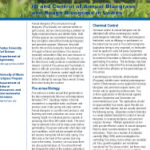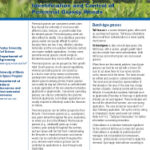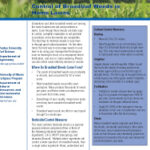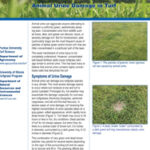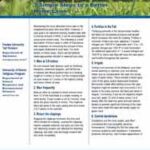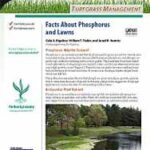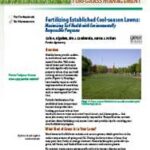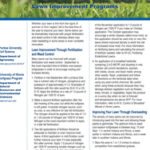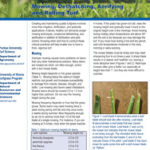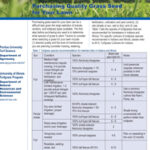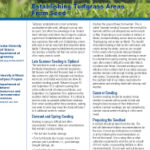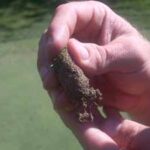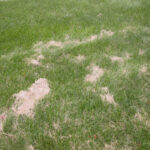Cale Bigelow
ID and Control of Annual Bluegrass and Rough Bluegrass in Lawns (AY-41-W)
Purdue Extension Publication
Controlling annual bluegrass (Poa annua) and rough bluegrass (Poa trivialis) in lawns is difficult, and relies on both cultural and chemical control. This publication describes these weeds and offers management strategies.
Animal Urine Damage in Turf (AY-327-W)
Purdue Extension Publication
Animal urine can aggravate anyone attempting to maintain a uniformly green, aesthetically pleasing lawn. For homeowners, pets (particularly dogs) are the most frequent cause of patches of darker green and/or brown turf, that are often concentrated in a particular part of the lawn. This publication describes symptoms of animal urine damage in turf and provides some management solutions.
7 Simple Steps to a Better Homelawn (AY-32-W)
Purdue Extension Publication
Maintaining the most attractive homelawn in the neighborhood takes time and effort. However, if your goal is a good-looking, healthy lawn with a minimal amount of effort, it can be accomplished using some simple steps. The following is a brief description of those steps in order of importance, with emphasis on minimizing the amount of time and input dedicated to your lawn. test
Facts About Phosphorus and Lawns (AY-334-W)
Purdue Extension Publication
This publication for both professionals and homeowners examines the role that phosphorus plays in turfgrass growth, explains how to determine the needs of specific turf stands, and provides suggestions for proper application to reduce the risk of contaminating surface waters.
Fertilizing Established Lawns (AY-22-W)
Purdue Extension Publication
Fertilizing established lawns keeps the lawn looking good and reduces how much you have to water and control weed, insect, and disease pests — that saves you money and is environmentally responsible. This publication answers questions about fertilizing cool-season lawns and provides tips for creating your own fertilization program.
Mowing, Thatching, Aerifying, and Rolling Turf (AY-8-W)
Purdue Extension Publication
A publication that gives suggestions for maintaining turf by effective mowing, thatching and aerifying.
Purchasing Quality Grass Seed for Your Lawn (AY-25-W)
Purdue Extension Publication
This publication provides help when selecting turfgrass for different lawns. Things to look for on a bag of quality grass seed are also covered. It also defines key terms that are used with planting and maintaining turfgrasses.
Bermudagrass Winterkill Again?
Some are suffering through another year of bermudagrass winterkill in Indiana. Much different than last year where winterkill was widespread and there were many different causes (too cold, too wet, too shaded, etc.), the primary cause for winterkill in 2014-2015 in Indiana appears to be confined to immature bermudagrass. Those that were not able to […]
Rounds 4 Research
Rounds 4 Research is an innovative program aimed at generating resources to fund research and help ensure golf’s future. The premise is simple: Golf facilities can support the effort by donating rounds of golf for two or four or “stay and play” packages and other items that will be auctioned off online to generate funds […]
Purdue Annual Turfgrass Research Report
As the green industry continues to have a large impact on Indiana and the nation, Purdue University has assembled an outstanding team of researchers, extension personnel, and educators that are dedicated to solving problems and helping meet the needs of Indiana residents. One segment of the Indiana green industry that continues to provide a significant […]
Record drought and heat are making seedling establishment a serious challenge
After the extremely stressful summer conditions of 2010 many thin areas in cool-season lawns have been reseeded to restore turf density and improve appearance. Regardless of environmental conditions, establishing a turf from seed is a challenge and the process is as much art as it is science. Seedling establishment requires two steps, germination and development. […]
Lawn Cultivation: Is now the time?
Lawns are cultivated (sometimes referred to as aerfication) primarily to relieve soil compaction and manage thatch (organic) layers. Other reasons may be to open the turf canopy and create a seedbed in order to facilitate interseeding or overseeding, or move certain nutrients, composts, pesticides etc. into the rootzone. Common questions regarding lawn cultivation: What are […]
Time to make the donuts… or better yet, time to cultivate!
A shallow root system in putting green bentgrass, this plant may not tolerate deep cultivation very well Surface following solid-tine cultivation procedure, notice the rootzone mixture on the surface, the point, be careful and be gentle! A Late-Summer Cultivation Checklist: Considerations for Success: What you are trying to accomplish with this practice? Organic matter/thatch removal? […]
Warm Weather and Spring Mowing Woe’s
For those that are managing cool-season lawns like Kentucky bluegrass, the ryegrasses or fescues the unseasonably early warm spring weather has resulted in quite a bit of shoot tissue (leaf clippings) being produced. For many that think they want their lawns to look like a closely cropped and highly manicured golf course, this may have […]
Spring Mowing Tips
Last week’s warm temperatures really made the grass green-up and begin growing which means many people are starting to think about seasonal mowing. Probably one of the biggest mistakes homeowners make is not starting to mow their lawns soon enough. Remember the mowing “rule of thumb”. For optimum turf health “try not to remove more […]

